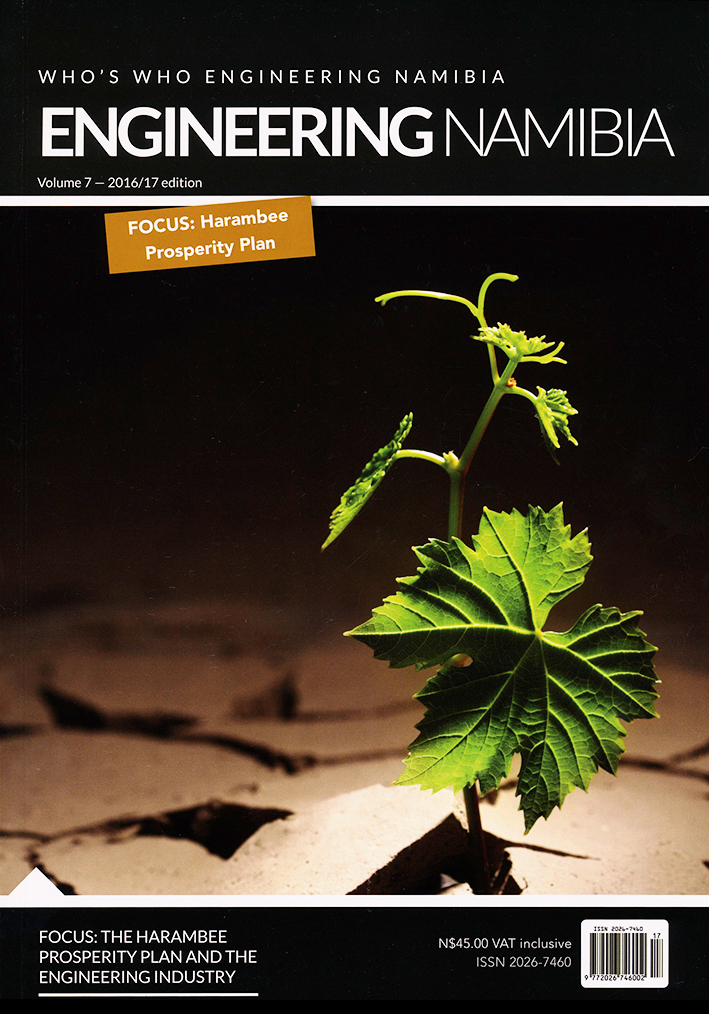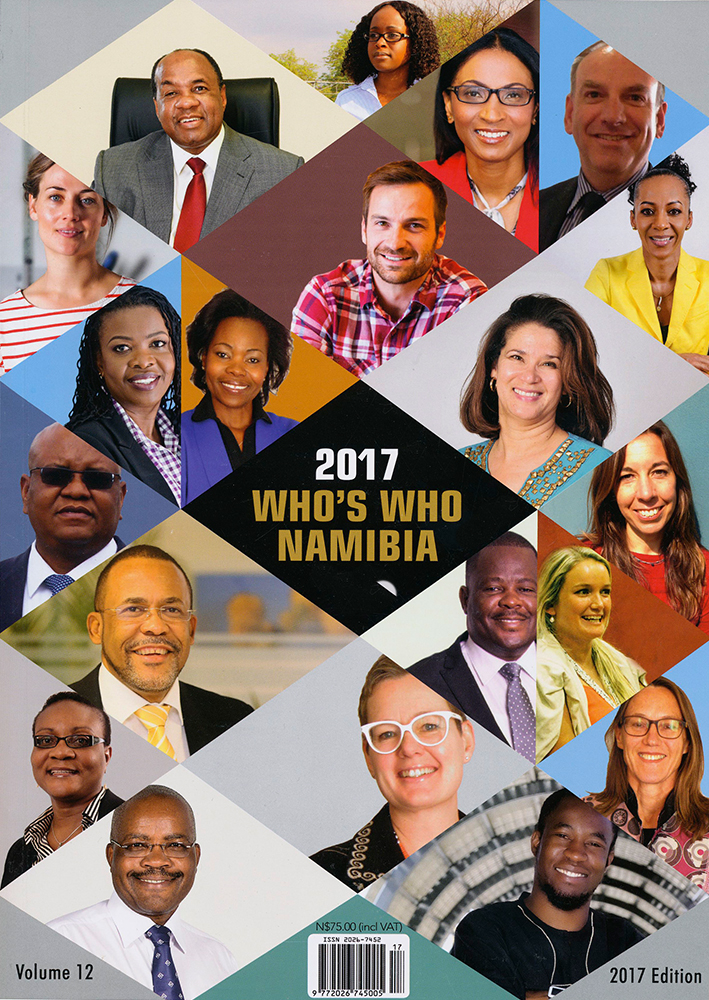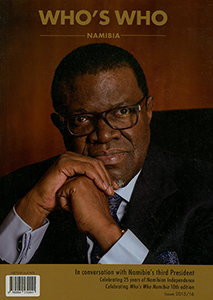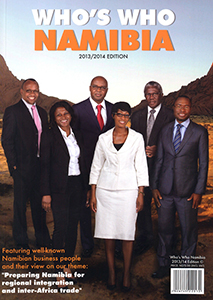Who's Who Engineering Namibia 2016/2017 (Volume 7), by Thea Visser
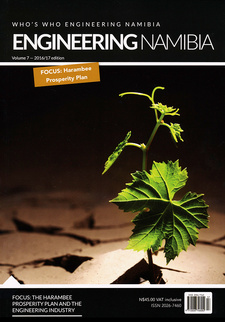
Who's Who Engineering Namibia 2016/2017 (Volume 7), by Thea Visser. Publisher: Virtual Marketing. Windhoek, Namibia 2017. ISSN 2026-7460. ISBN 9772026746002
Who's Who Engineering Namibia 2016/2017 (Volume 7) is a product of Virtual Marketing Publishers, a Namibia company founded by it's Managing Director Thea Visser. The publisher focusses on Who's Who Namibia and industry-specific publications, integrated annual reports and corporate publications.
THE HARAMBEE PROSPERITY PLAN AND THE CHALLENGES OF MEETING NATIONAL ENERGY DEMAND
When Dr Hage Geingob presented the Harambee Prosperity Plan towards the end of his first year in office, he was clear that the development of the document was not intended to reinvent the wheel but that its proposals should be read in tandem with, and as complementary to, the long-term goals already contained within Namibia's National Development Plans (NDPs) and Vision 2013. The word 'prosperity', as it applies to both the name of the Harambee Prosperity Plan and the simple objectives included within the Plan was, he stated in his Foreword to that publication, to be understood in the broadest of terms, as relating not to material extravagance or financial riches but to the basic human needs that Namibia's citizens must have met in order for them to survive, flourish and contribute to the success of the nation. Indeed, interventions relating to assuring equitable access to a wide range of resources have comprised a critical component of our national development plans going right back to the earliest days of our country's independence. One key resource that Dr Geingob identified as being necessary for an 'enabling environment', and one reinforced in the course of community engagement activities throughout the country during 2015 at the Plan's information-gathering stage, was access to a guaranteed energy supply. This seems like a statement that requires no reiteration yet the failure, to date, to ensure such a nationwide supply for all Namibians, but especially those living in rural communities, has had a profound effect, on their ability to avail themselves of educational opportunities and engage in enterprise development on a personal level. » Namibia's electricity demand is currently about 600 MW per year; the country's total generating capcity of only 400 MWper year with demand expected to grow by 5 per cent per annum.« And this is without addressing the wider context: the need for power to run our networks of schools, hospitals, clinics, regional institutions, communications technologies, and those organisations that are at the forefront of challenging the inequalities still prevalent in our society, to name but a few. In the four-year period of its implementation, the HPP is aiming to re-focus attention and resources, as well as budgetary allocations of course, towards urgent infrastructural projects that operate at a large scale but that have impacts at the level of the individual when it comes to energy supply, so that the war against poverty can be fought in the homestead and the bush school as well as at the industrial parks and the container terminal. To this end, the recent and growing interest in the suitability of solar and other renewable sources of energy to meet many of our power requirements has naturally fed into the 'Energy infrastructure' sub-pillar of the Harambee Prosperity Plan. In order to further capitalise on the economic gains and social progress that have been achieved since 1990, it will be necessary for the Ministry of Mines and Energy to act with alacrity on the stated commitments that the Harambee Prosperity Plan makes towards rectifying shortages in locally generated electricity, for example, and ensuring truly nationwide coverage. The wide scope of the key performance indicators for energy infrastructure contained within the Detailed Implementation Plan (Appendix 5) of the Harambee Prosperity Plan, along with the number and diversity of the milestones set out to mark progress towards individual sub-pillar goals, together comprise a clear road map towards securing national coverage in respect to sustainable energy supplies. How does the Harambee Prosperity Plan define its goals for the energy sector and benchmark progress towards them? [...]
This is an excerpt from Who's Who Engineering Namibia 2016/2017 (Volume 7), by Thea Visser.
Title: Who's Who Engineering Namibia
Series: Volume 7; 2016/2017 edition
Executive editor: Thea Visser
Publisher: Virtual Marketing
Windhoek, Namibia 2017
ISSN 2026-7460
ISBN 9772026746002
Softcover, 21 x 30 cm, 220 pages, throughout photographs
Visser, Thea im Namibiana-Buchangebot
Who's Who Engineering Namibia 2016/2017 (Volume 7)
Who's Who Engineering Namibia 2016/2017 (Volume 7) focusses on the Harambee Prosperity Plan and Namibias Engineering Industry.
Who's Who Namibia 2017 (Volume 12)
Who's Who Namibia is Namibia's premier source of information and references. This is Volume 12, 2017.
Who's Who Career Guide for Future Leaders (in Namibia)
Who's Who Career Guide for future leaders in Namibia offers a reasonable concept for making first successful career decisions right from the start.
Who's who Namibia 2015/2016 (Volume 10)
Who's Who Namibia is the leading guide to everyone who's anyone in Namibia. (Volume 10, 2015/2016)
Who's Who Namibia 2013/2014
Who's Who Namibia is the leading guide to everyone who's anyone in Namibia. This is volume 9, the 2013/2014 edition.

